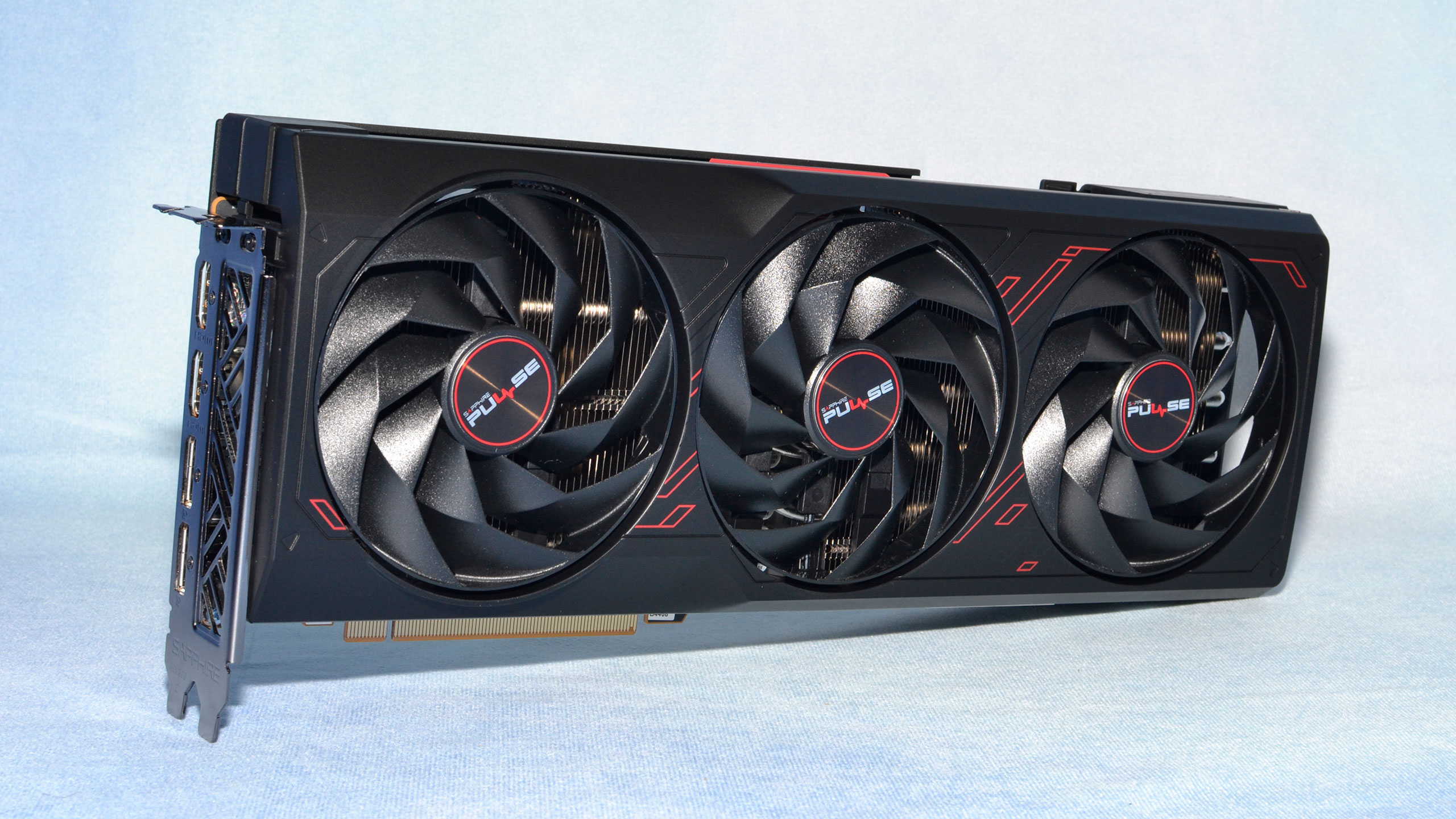Why you can trust Tom's Hardware
As usual, we focus our performance testing on native resolution, without frame generation, unless otherwise noted. Starting with our 1440p results, this represents the target resolution for a card like the RX 7900 GRE — you can run 1080p or 4K or ultrawide resolutions as well, but 1440p is a good starting point.
We have tried AMD Fluid Motion Frames (AFMF), to see how it feels and looks, and our initial impressions were not great. Its driver-level frame generation tries to inject extra frames, but the feel of several games that we tried was worse than with AFMF disabled. Your mileage may vary, and it does seem to have more issues in more demanding games — precisely the sort of games where you'd be more likely to use frame generation.
We'll start with the high-level overview, then the rasterization results, and finally ray tracing performance. We also have our bonus games at the bottom of the page, which are not factored into the other geometric mean charts.
AMD RX 7900 GRE 1440p Overall Performance
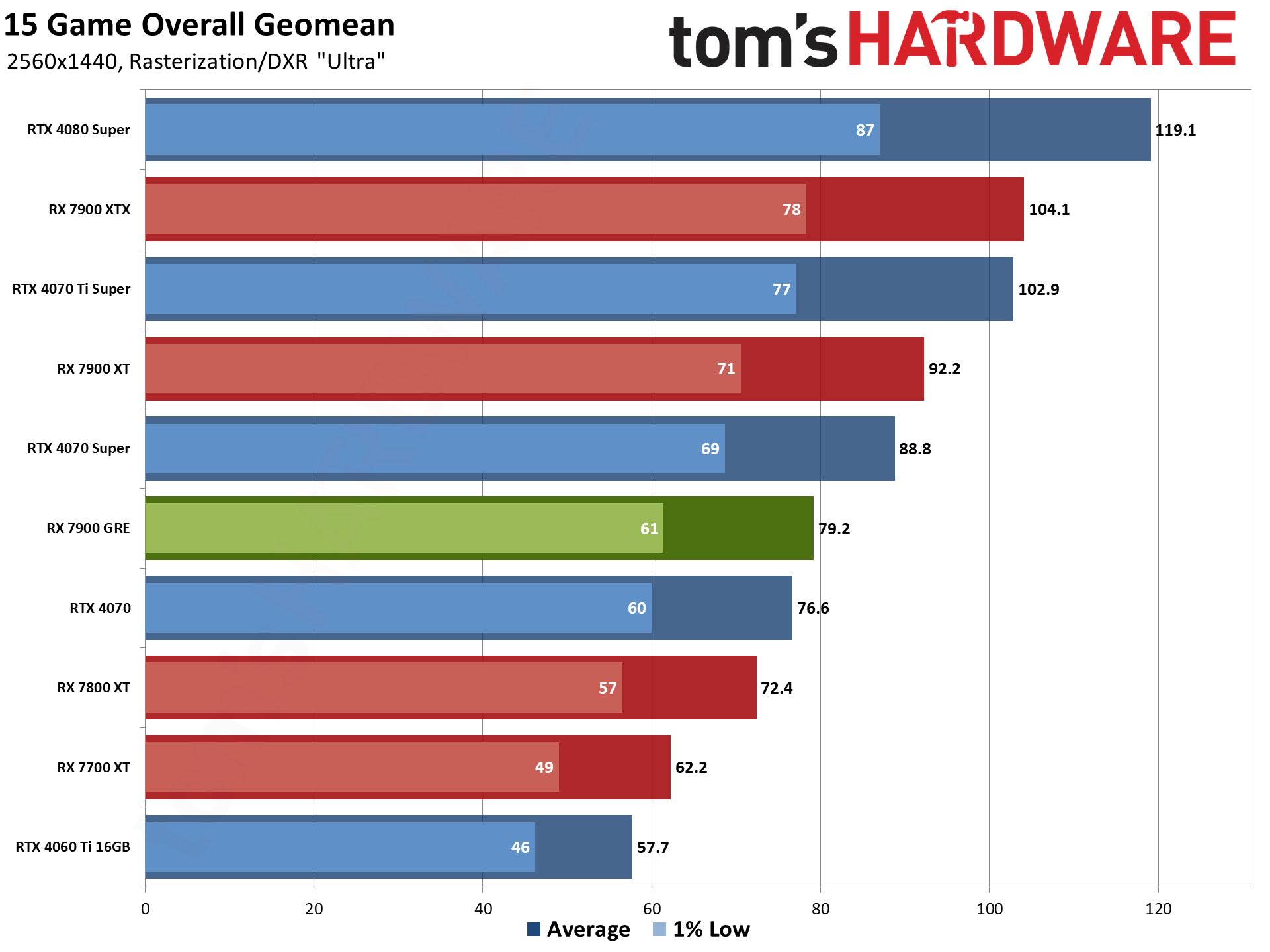
AMD's goal with the RX 7900 GRE is to take on the now reduced price RTX 4070. At 1440p ultra, you can see that our overall 1440p chart shows it coming in just slightly ahead of the RTX 4070 — with a 3.4% lead. The 7900 GRE on a 4070 is also slightly higher than the lowest priced RTX 4070 at present, so it costs 3.8% more. You basically get performance roughly in line with price.
The composite score of 79 fps means that most of the games in our tests suite are breaking 60 fps. We'll have the individual charts below, but every rasterization game averaged 80 fps or more, while only one ray tracing game cleared 60 fps (barely). It's the usual story of AMD beating Nvidia in rasterization and losing in ray tracing.
1440p also ends up being the best result for the 7900 GRE when comparing it to other nearby AMD GPUs. It's 9.3% faster than the 7800 XT, again showing linear scaling in FPS per dollar spent. The 7900 XT meanwhile leads the GRE by 16.5%, so there's still quite a gap between the new card and the next step higher.
AMD RX 7900 GRE 1440p Rasterization Performance
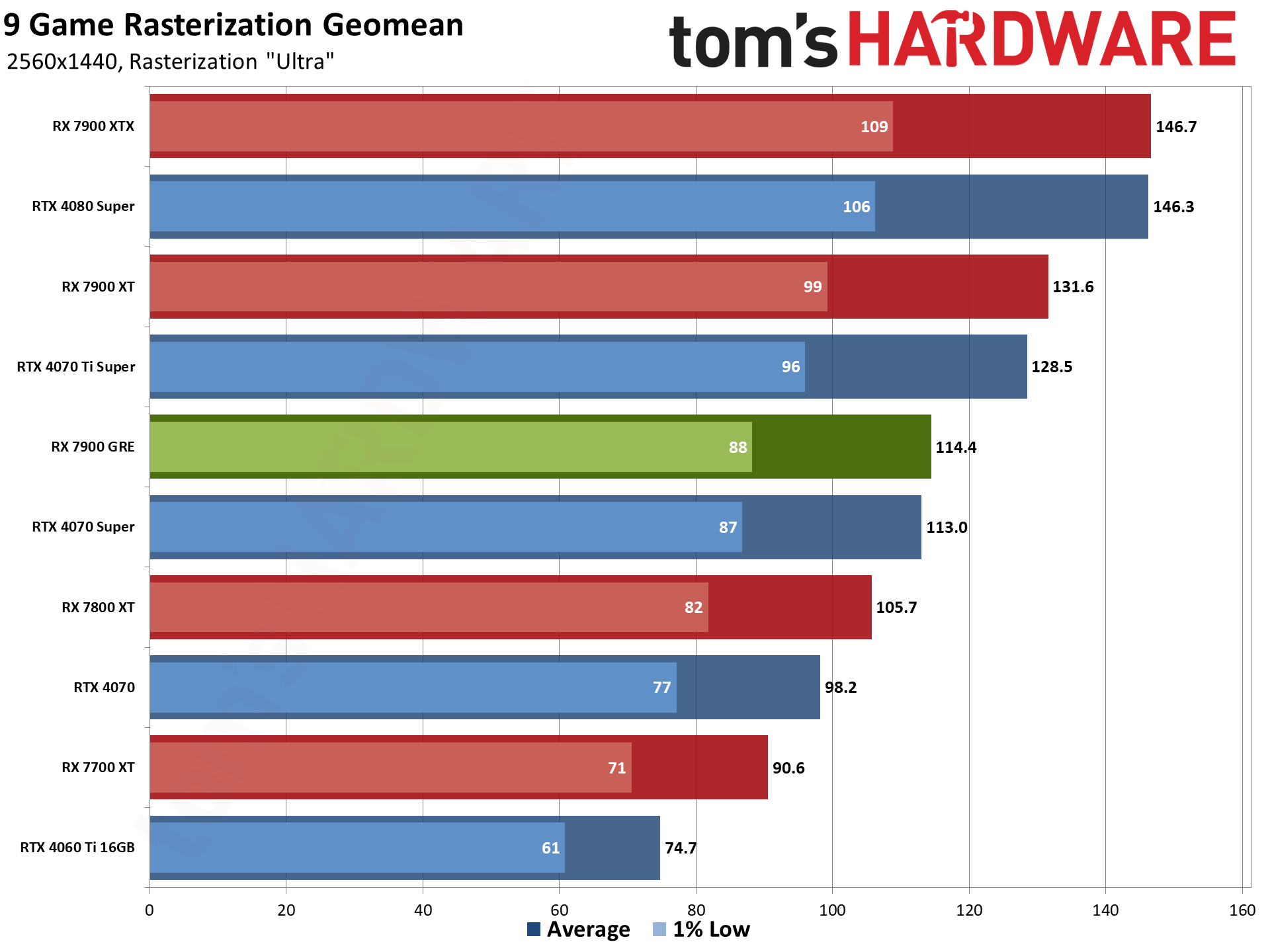

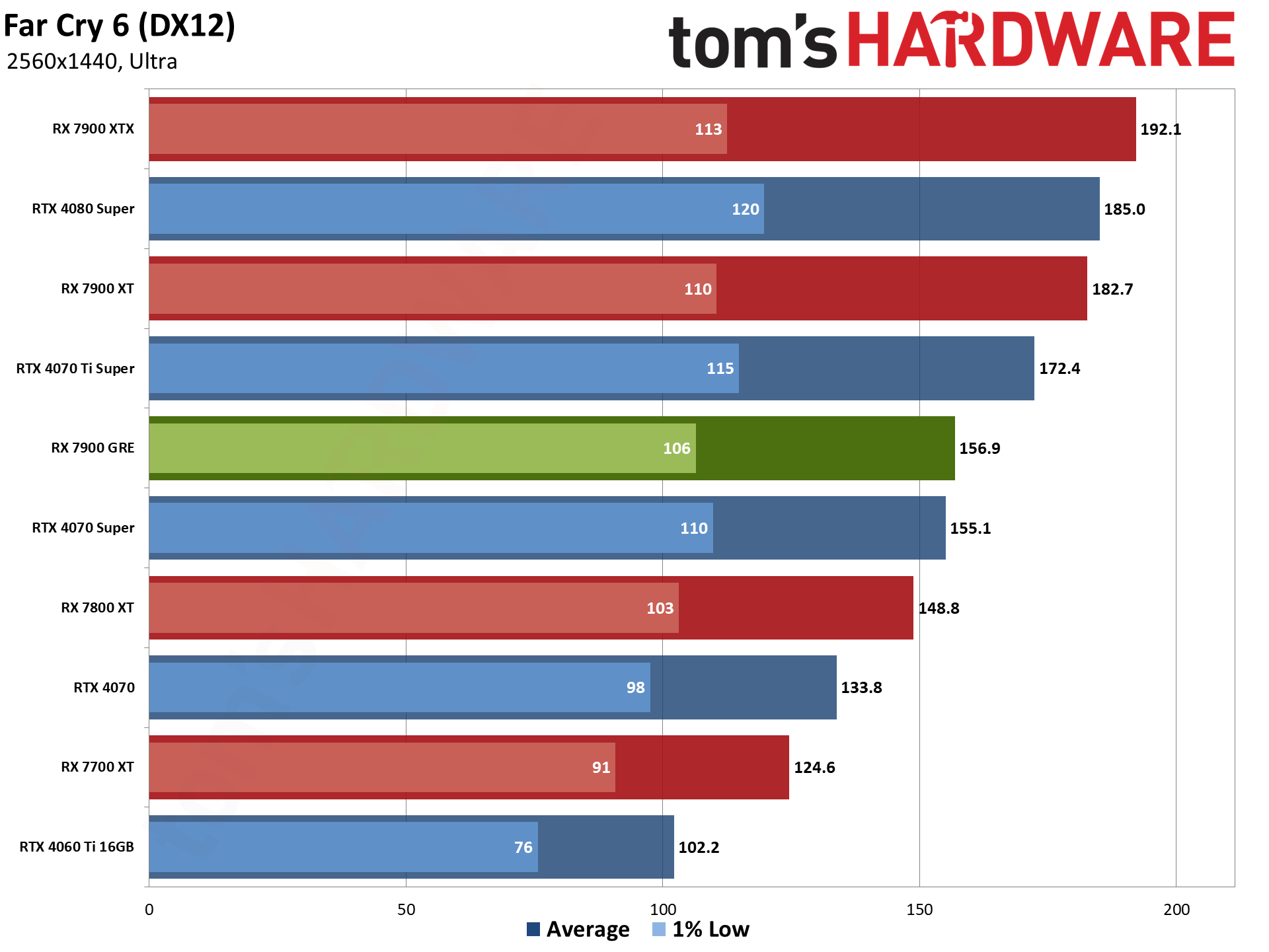

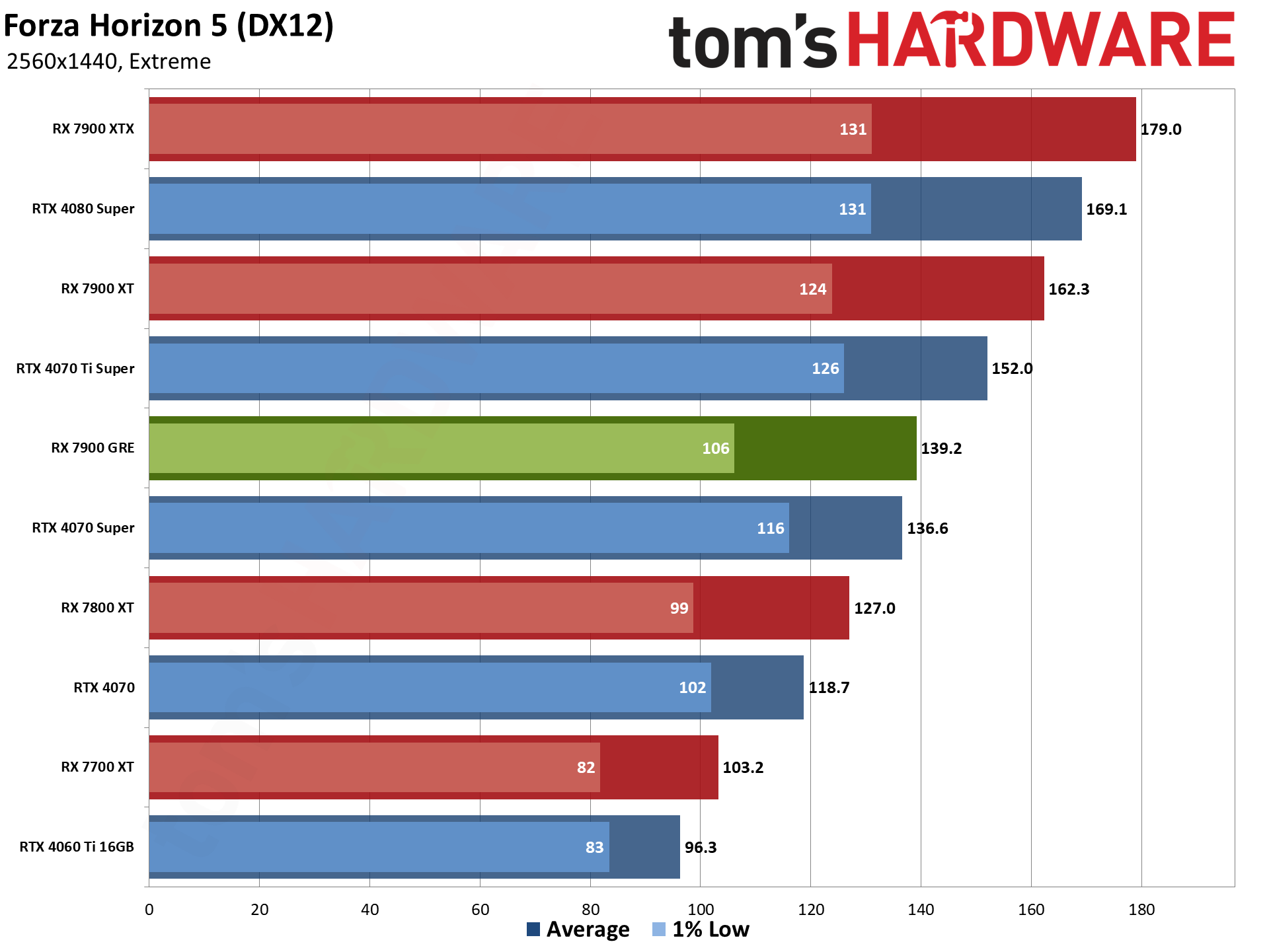
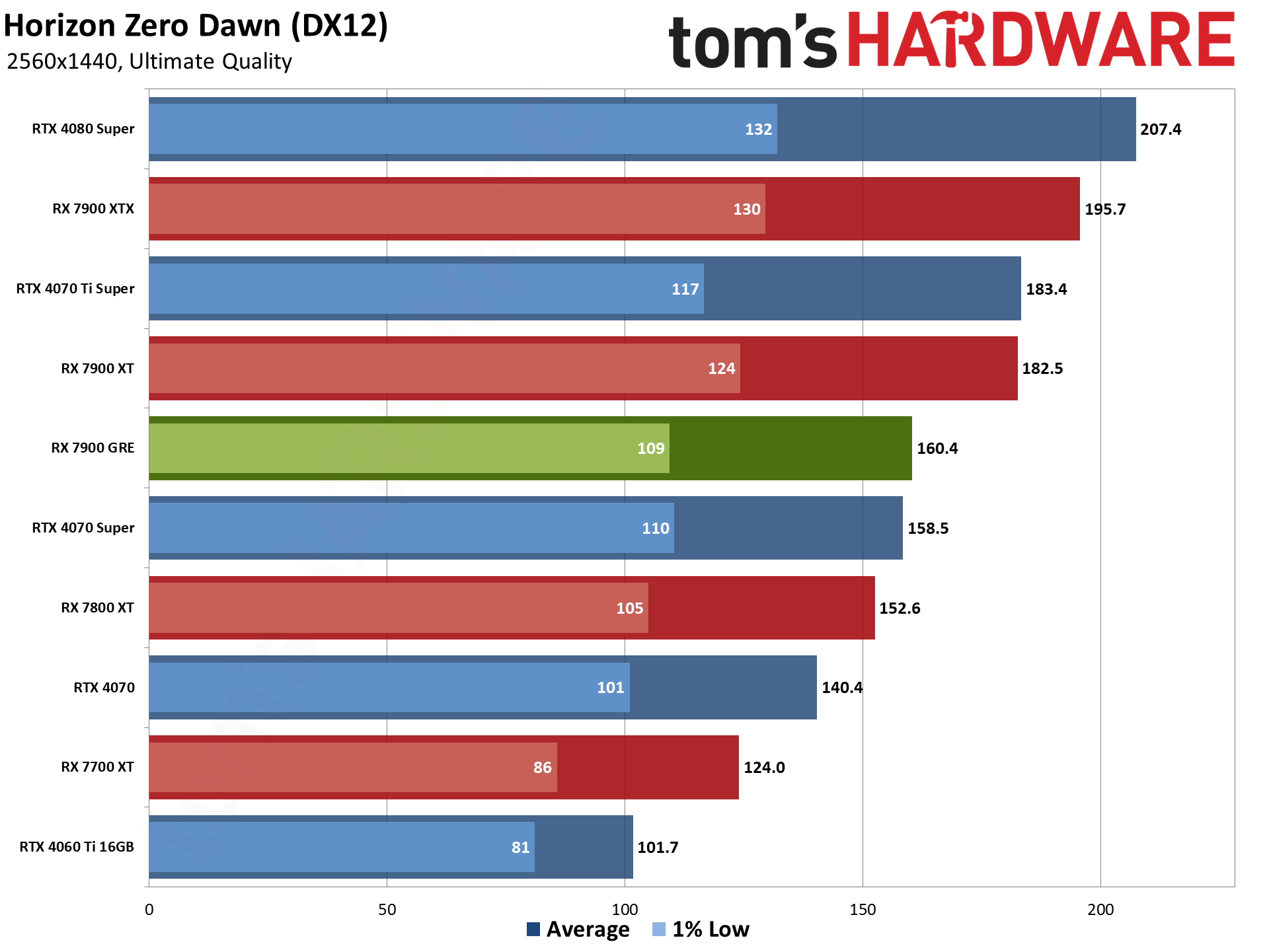
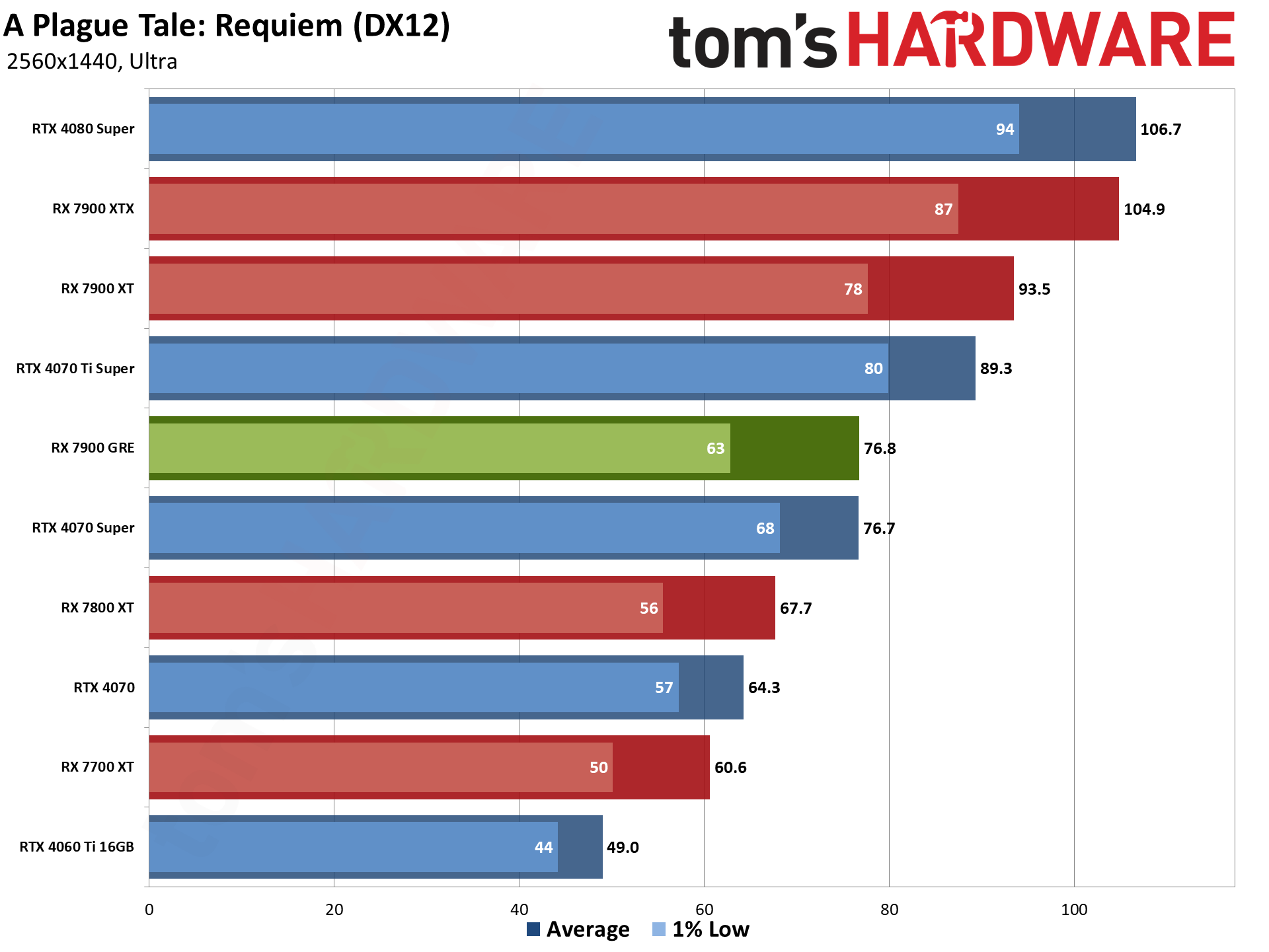

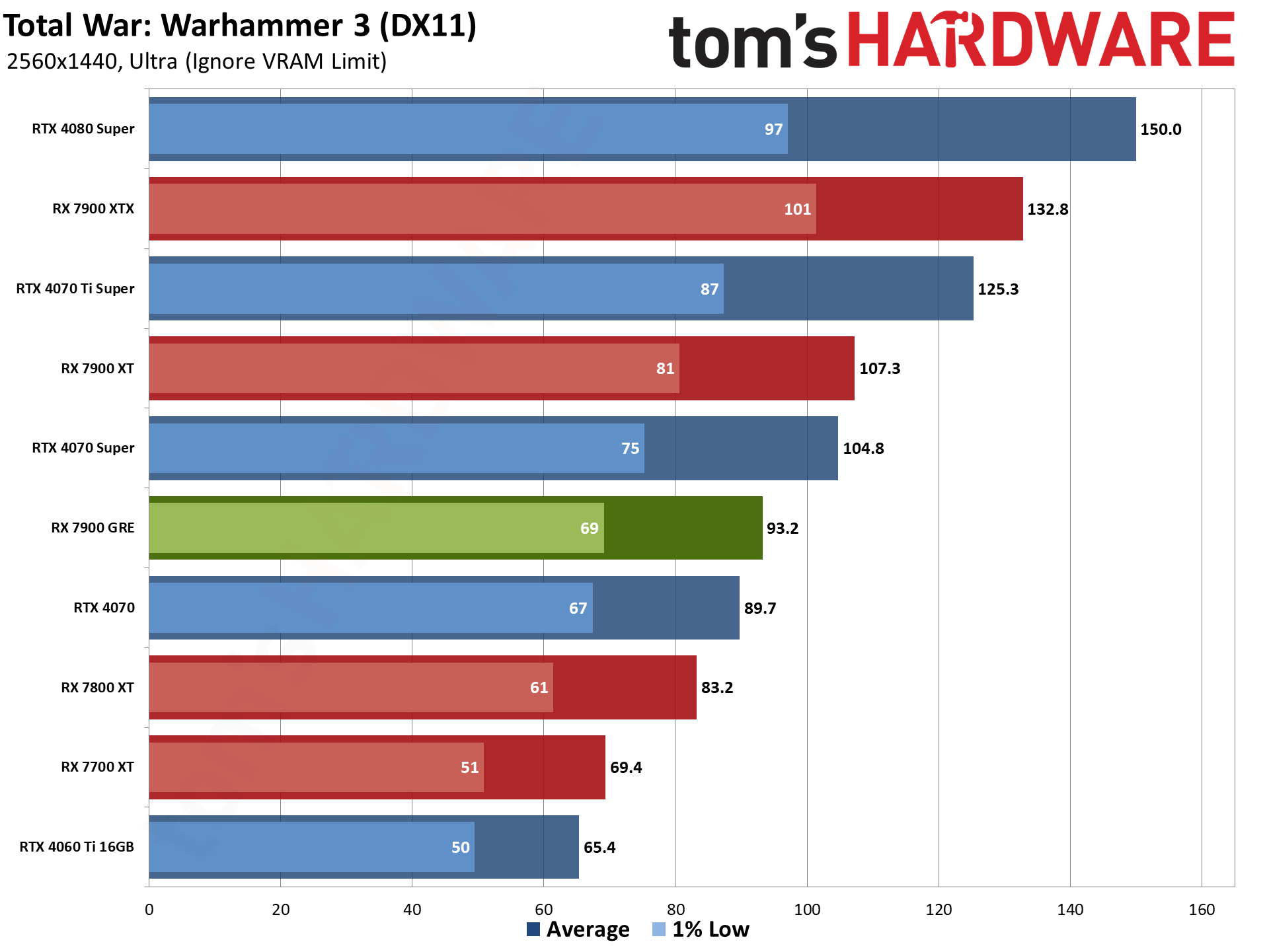
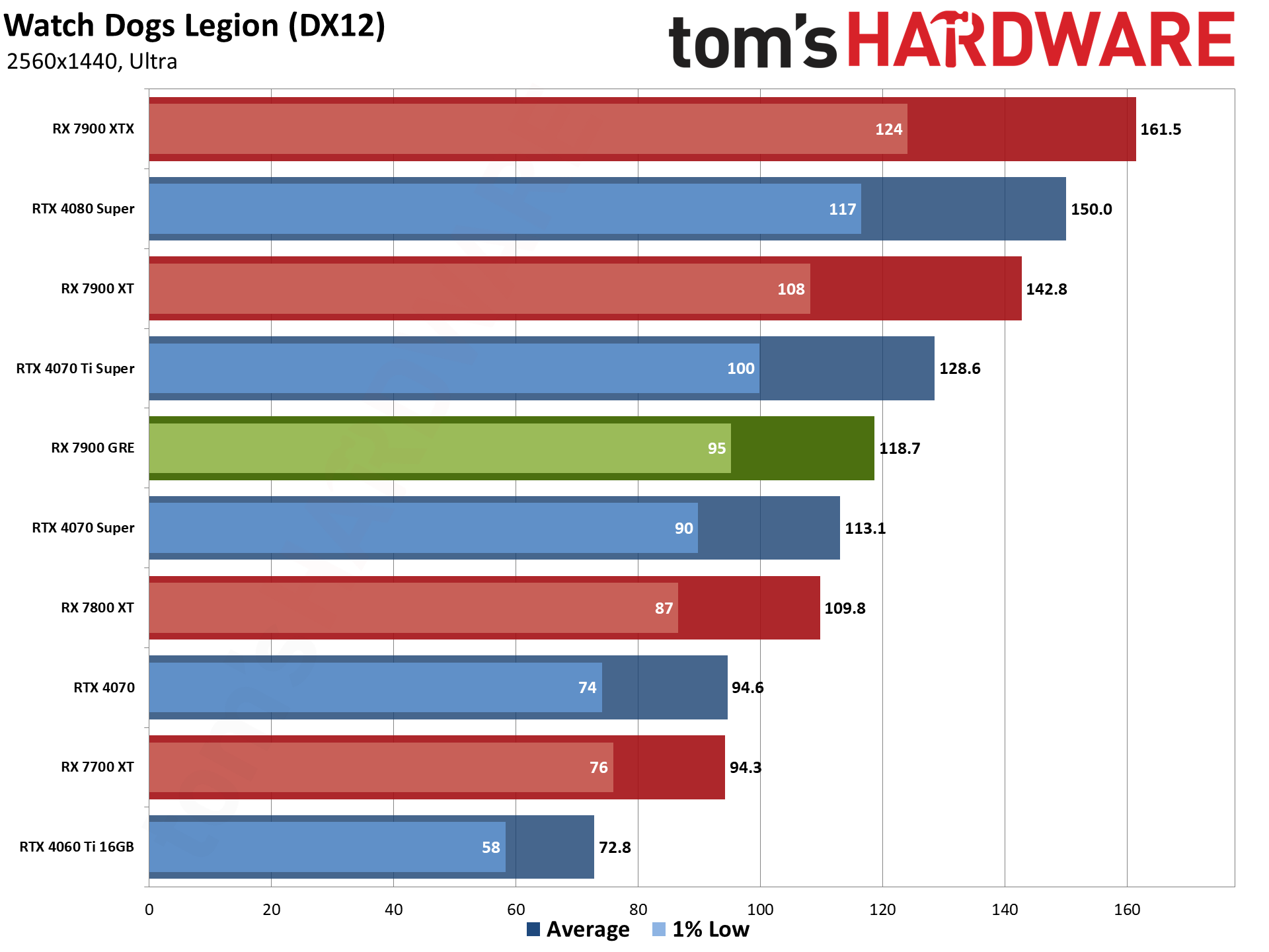
Rasterization games are a strong point for AMD and the 7900 GRE. Overall, it basically ties the more expensive RTX 4070 Super, with a negligible 1.3% lead. The individual games meanwhile show a range of -11% (Total War: Warhammer 3) to +15% (Borderlines 3), though five of the six remaining games show less than a 2% difference — Watch Dogs Legion has the GRE winning by 5%.
Against the similarly priced vanilla RTX 4070, of course, AMD's RX 7900 GRE delivers much better performance. It's 17% faster overall in our rasterization tests, with a lead ranging from 2% (Flight Simulator, which is CPU limited even at 1440p on these GPUs) to 35% (Borderlands 3, as usual).
1440p with rasterization is also a great option for people with high refresh rate displays, particularly those with VRR (variable refresh rate) technology like FreeSync and G-Sync. The 7900 GRE averages 114 fps and ranges from 77 fps (Plague Tale: Requiem) to 160 fps (Horizon Zero Dawn).
Note that 1440p matches the FSR 2/3 Quality upscaling resolution at 4K, and while there's some overhead, in general all the rasterization games with FSR 2/3 upscaling support should also be able to run just fine at 4K.
AMD RX 7900 GRE 1440p Ray Tracing Performance
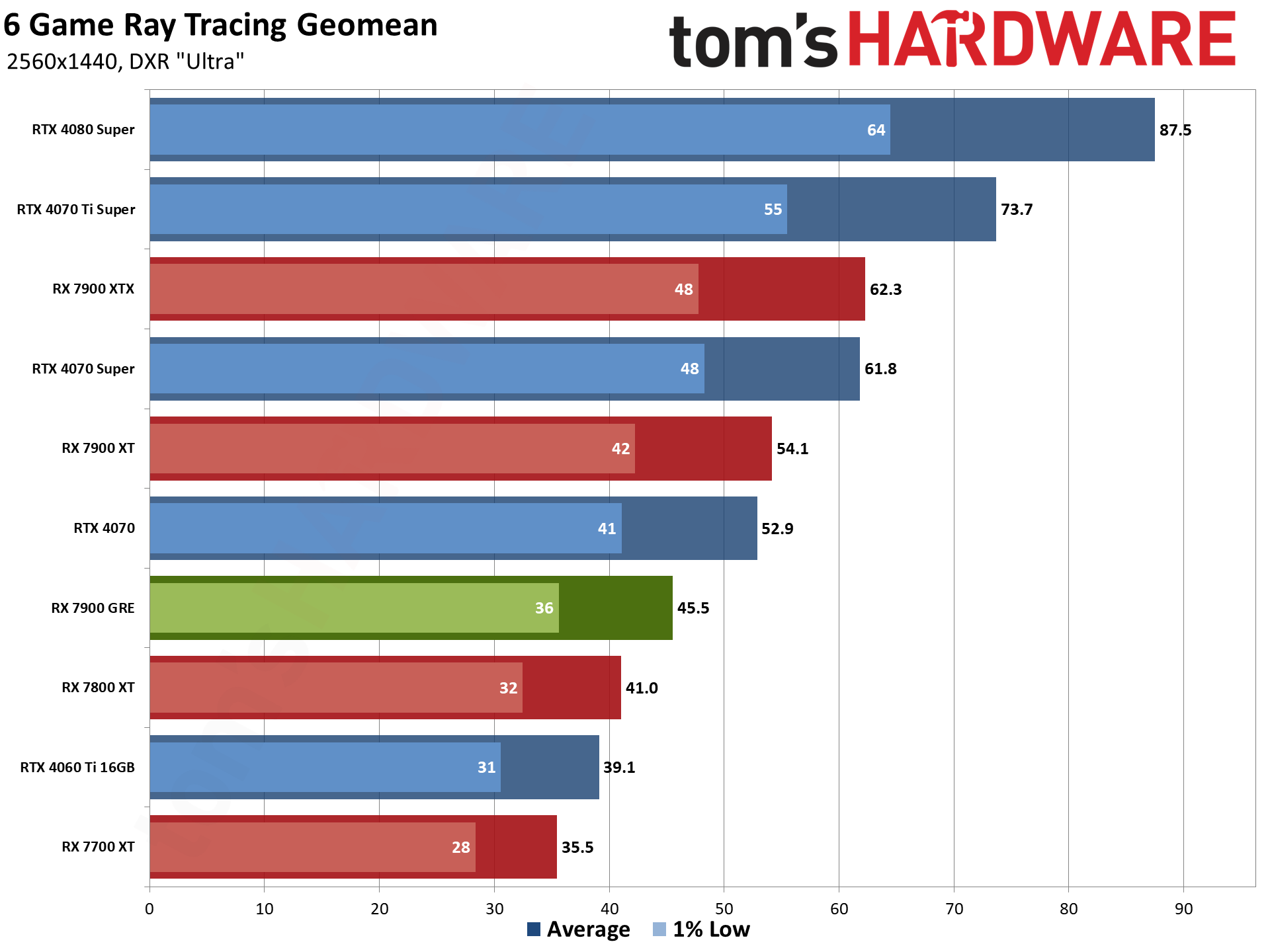


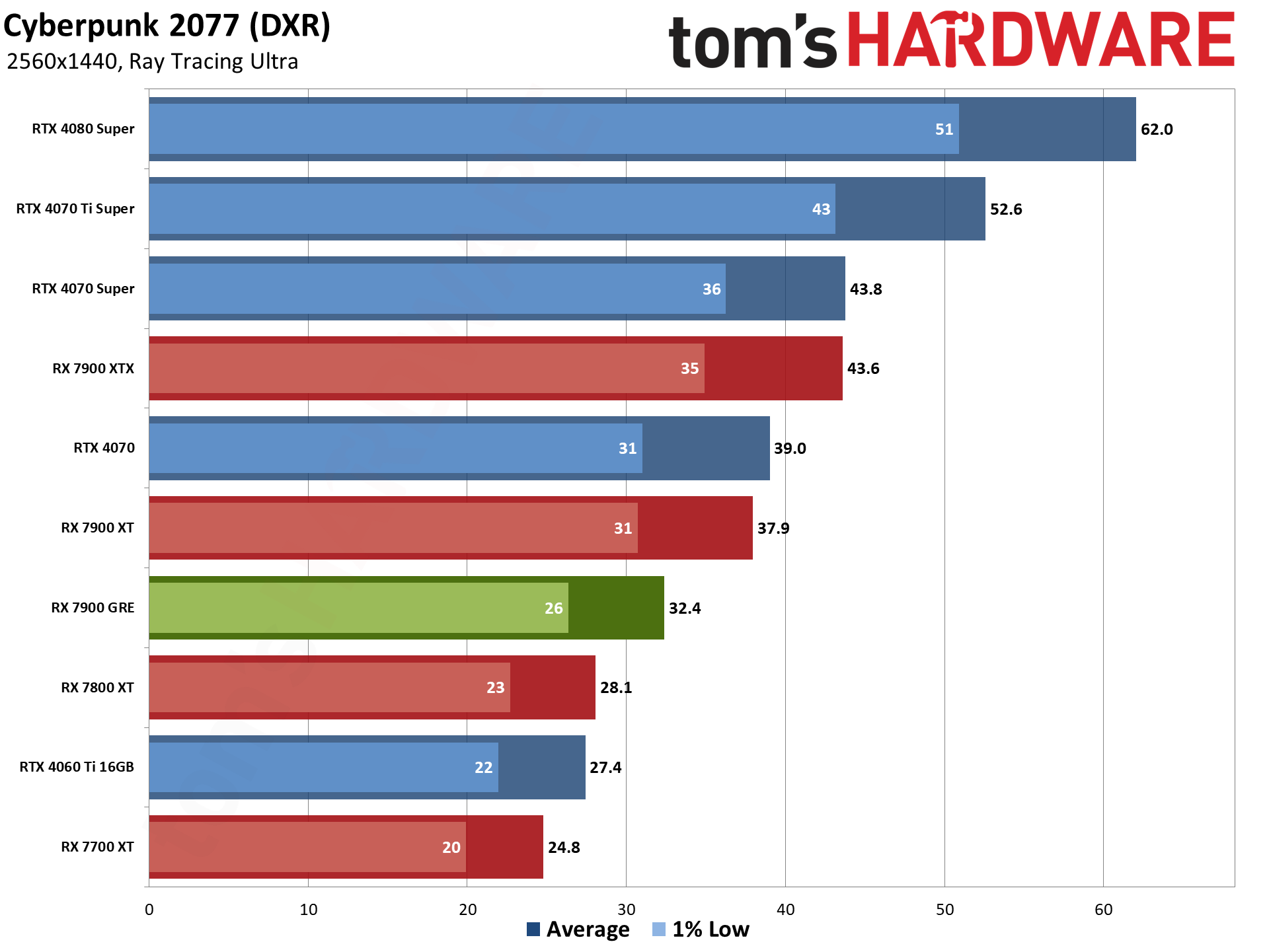


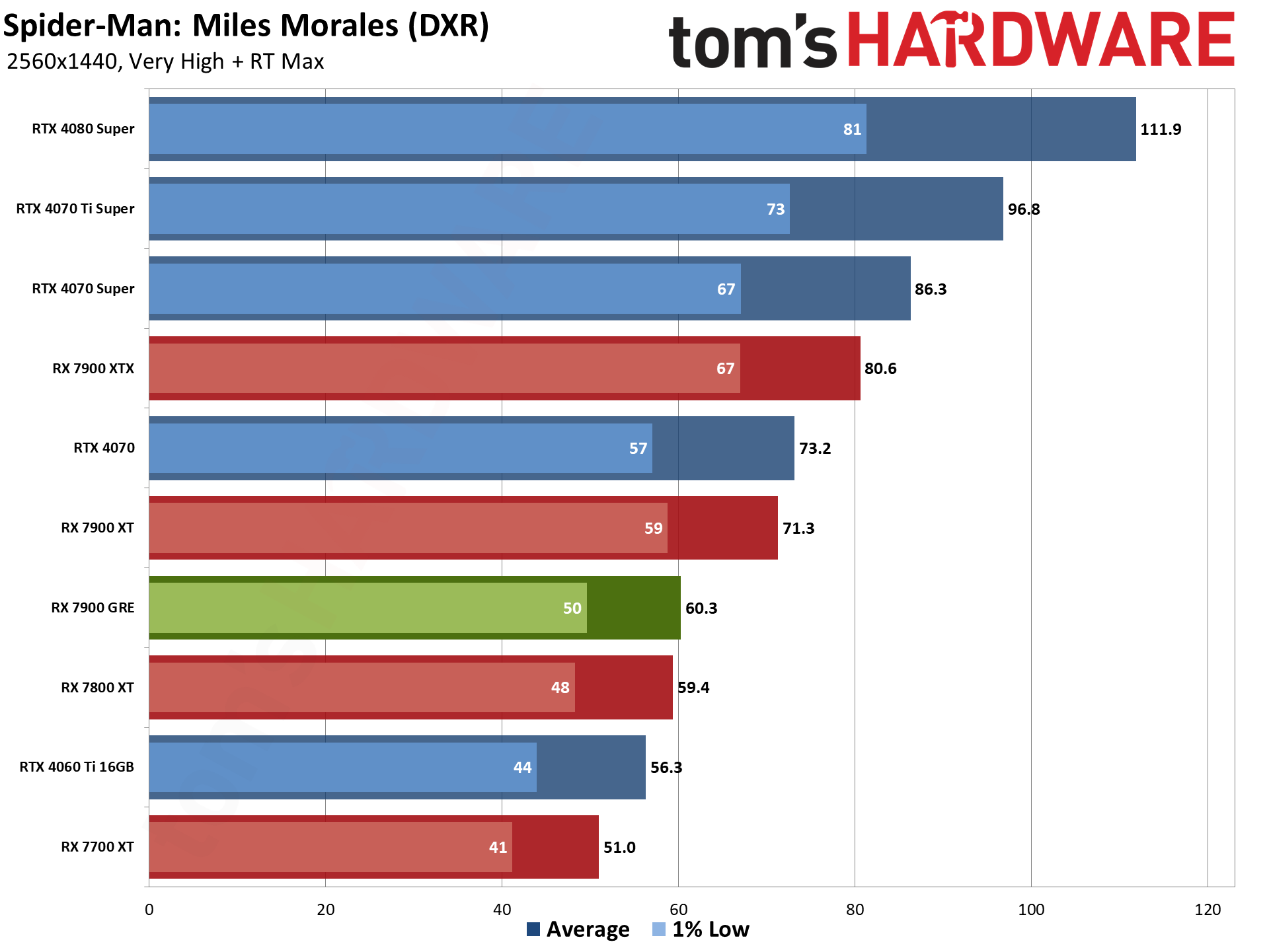
Ray tracing continues to be less of a focus for AMD GPUs — and it's not just about raw performance. We've noticed minor differences in rendering quality with a few ray tracing games, plus AMD-promoted games that use ray tracing (like Avatar: Frontiers of Pandora) almost always seem to not do as much with the technology. Minor differences in shadows and reflections may still be noticeable, but often the Nvidia-promoted games that use ray tracing gave clearly superior shadows, reflections, and other lighting effects.
Here the RTX 4070 ends up beating the RX 7900 GRE by 16% overall, with a range of -2% (Metro Exodus Enhanced) to +53% (Minecraft). DLSS Quality mode is also supported in all six of the DXR games we're testing, while FSR 2/3 is only in half of the games — and that's true in general, DLSS is in about twice as many games as FSR 2.3. Both can give about 30~50 percent higher performance, though DLSS still looks superior in a lot of cases.
That's the Nvidia advantage right now. It has superior ray tracing hardware, coupled with superior AI hardware, and then paired with more developer engagement to get games to utilize both features. It's the combination of hardware and software that proves so enticing.
Many people will say that ray tracing performance doesn't matter, but the more accurate statement would be that you should not plan on competitive ray tracing performance if you use and AMD card. It's still not a huge problem, as few games really use the technology in ways where the resulting difference in image quality makes the performance hit justifiable. But you can certainly experience FOMO if you opt for non-Nvidia hardware — particularly if RTX Remix mods become more common.
AMD RX 7900 GRE 1440p Bonus Games
We have four more recent 'bonus' games as well. Alan Wake 2 is an Nvidia-promoted game that uses full path tracing when you select the high or medium ray tracing settings. It also supports DLSS 3.5 Ray Reconstruction, which improves the denoising quality on Nvidia GPUs. We test with FSR 2 or DLSS Quality mode upscaling (but without frame generation).
For this review, we've added Assassin's Creed Mirage, an AMD promoted game with a built-in benchmark (which seems to have inconsistent pacing compared to the actual game, but it's at least repeatable). The other two games are also AMD promoted. Avatar: Frontiers of Pandora has ray tracing enabled for all settings, though it doesn't push RT hardware as much as other games in our experience. It also has FSR 3 and DLSS 2 support, and we use Quality mode upscaling again to improve overall performance. Finally, The Last of Us, Part 1 has been around a bit longer and tends to run better than when it initially launched in earlier 2023.
Our bonus games are more demanding titles — much more demanding in the case of Alan Wake 2. Consider the use of three AMD promoted games versus one heavily Nvidia promoted game to be our way of trying to keep things somewhat balanced.
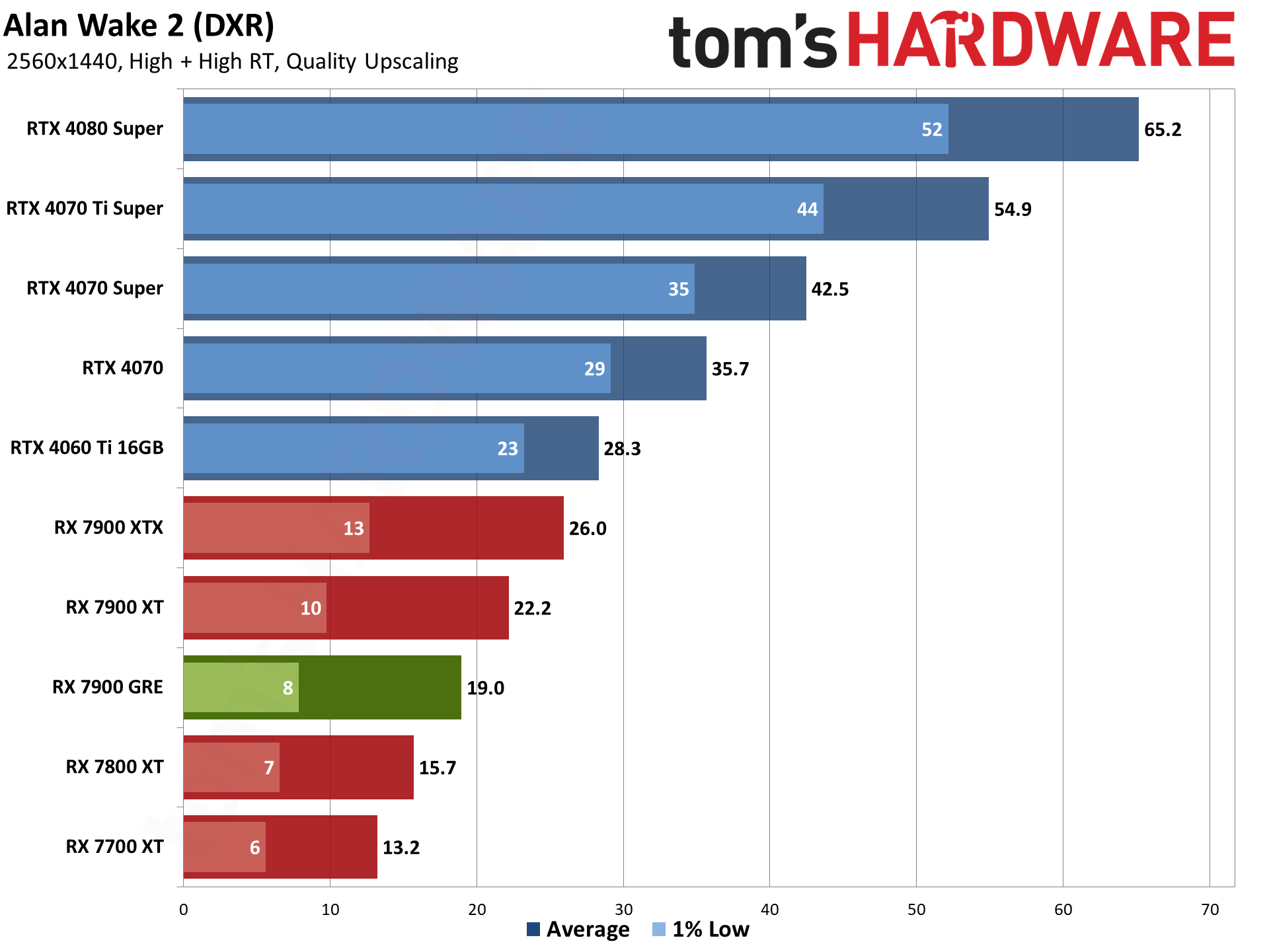

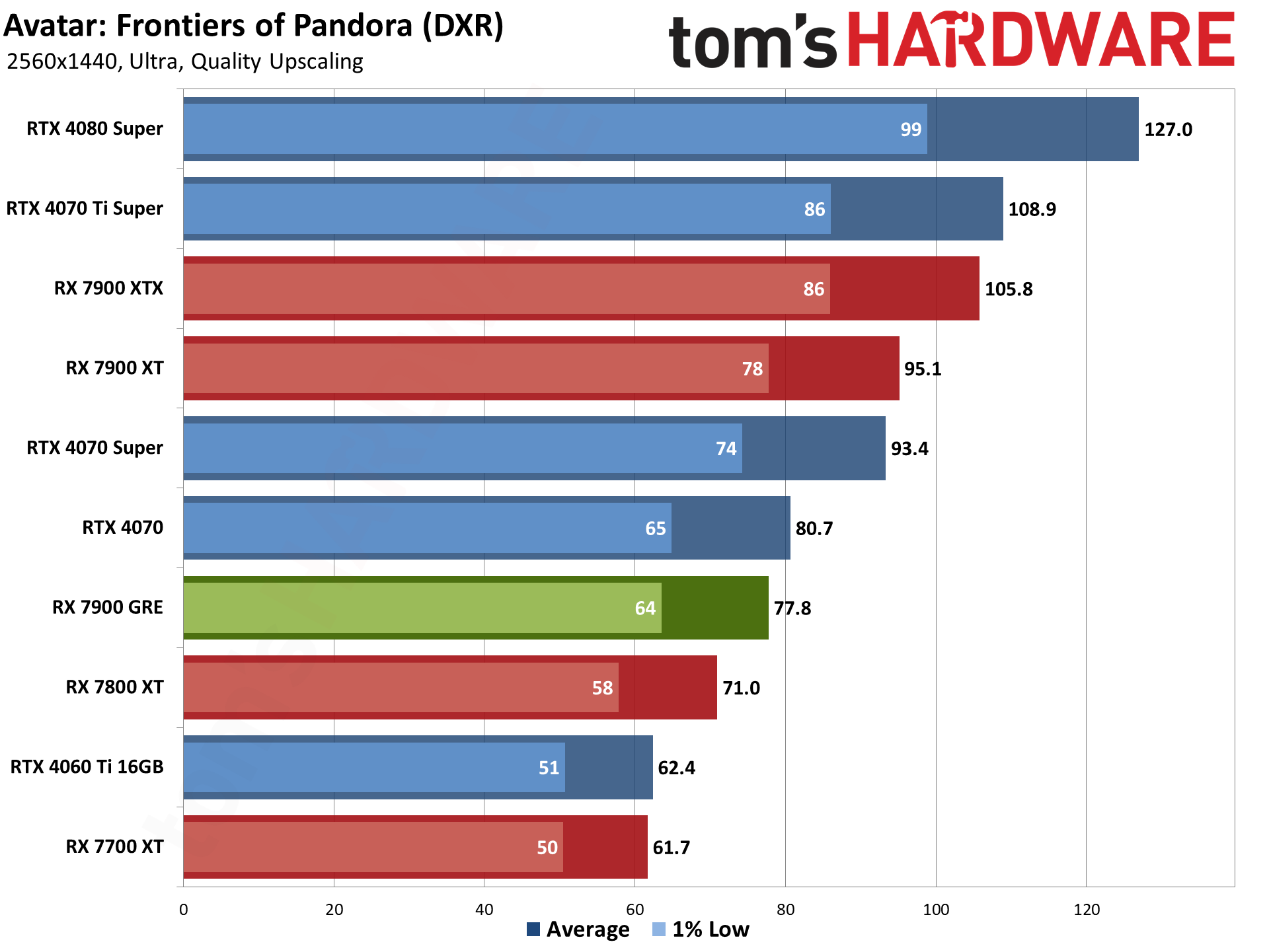
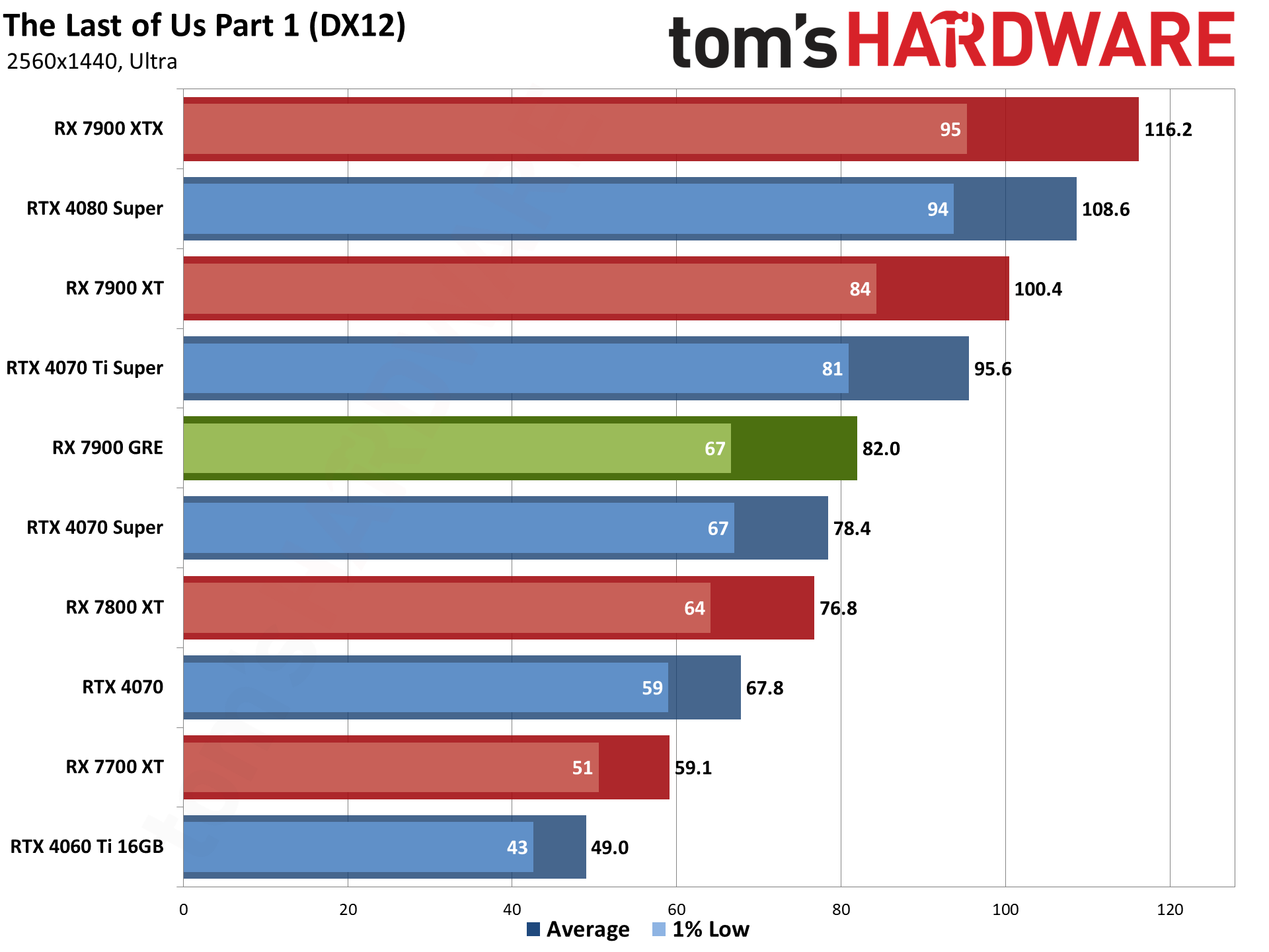
Starting with Alan Wake 2, 1440p with full path tracing just brutalizes AMD GPUs — even with upscaling. You basically need 4X Performance mode upscaling to actually get even close to playable performance from the faster AMD GPUs, and it still won't get the 7900 GRE above 30 fps. Even Nvidia's RTX 4060 Ti manages higher performance than any of AMD's GPUs at 1440p with path tracing enabled.
Assassin's Creed Mirage does much better, in part because it doesn't use ray tracing in any form. It zips along at a heady 117 fps, 6% ahead of the RTX 4070 and 4% ahead of the RX 7800 XT. It's not a huge advantage but it's at least something.
Avatar is also very playable at 78 fps, but this time the 7900 GRE comes in a few percent behind the RTX 4070. As noted above, the game uses some ray traced effects for shadows and reflections, though with no direct toggles to enable/disable ray tracing it's a bit hard to say how much the effects actually improve visuals.
Performance in The Last of Us, Part 1 echoes what we see with Borderlands 3, in that it's one of the games that most strongly favors AMD's GPUs. Here the 7900 GRE leads the RTX 4070 by 21%, and even beats the RTX 4070 Super.
- MORE: Best Graphics Cards
- MORE: GPU Benchmarks and Hierarchy
- MORE: All Graphics Content
Get Tom's Hardware's best news and in-depth reviews, straight to your inbox.
Current page: AMD RX 7900 GRE: 1440p Gaming Performance
Prev Page Sapphire Radeon RX 7900 GRE Pulse and Test Setup Next Page AMD RX 7900 GRE: 1080p Gaming Performance
Jarred Walton is a senior editor at Tom's Hardware focusing on everything GPU. He has been working as a tech journalist since 2004, writing for AnandTech, Maximum PC, and PC Gamer. From the first S3 Virge '3D decelerators' to today's GPUs, Jarred keeps up with all the latest graphics trends and is the one to ask about game performance.
-
Notton So it falls directly between a 7800XT and 7900XT, and should have been called the 7900.Reply
It looks really good as a 1440p card.
It's not that interesting, considering it's price tag.
I'll wait to see what the RTX 5000 and RX 8000 series brings to the table, unless my 1070Ti croaks first. -
Giroro I'm surprised they didn't completely rebrand the card for the west. More generally, I'm surprised they're releasing it in the west at all.Reply
10% more performance for 10% more money isn't exciting, it's pointless. If they feel the need to release a minor stop-gap card, then I think they won't be ready to release anything truly exciting anytime soon. Maybe the AI surge has made them go back to the drawing board with RDNA 4.
It's hard to explain, but In my mind, something about calling it "Golden Rabbit" severely devalues it. So I imagine they at least will never spell out that acronym. Gold isn't valuable or aspirational; it's always cheap, fake, and tacky.
Also, I don't associate rabbits with being fast - I associate them with the weak fluffy bunnies that keep tearing up my yard.
Calling it golden means its a knockoff. It makes me think the GPU is actually some ancient Radeon HD 7970 chip that somebody is fraudulently trying to pass off as a counterfeit RX 7900 on Temu for $80 - or that it might have a virus or set my computer on fire.
Maybe I just buy too much counterfeit garbage from overseas. -
UnforcedERROR The conversation at $550 right now is almost specifically 1440p raster, which the 7900 GRE performs handily in. At these prices, 16 GB vs 12 GB for the 4070 is the biggest argument in its favor. Neither card is competent in Ray Tracing at 1440p, and the price-to-performance difference isn't enough to argue much otherwise, so it's mostly about longevity.Reply
As others said, it's not terribly interesting, and it feels like a notably late arrival, but it's something I suppose. I still feel like the $500 - $700 segment of cards is wholly disappointing from both NVidia and AMD. -
ohio_buckeye So it’s basically similar performance to a 6900xt or a 6950xt it sounds like? I’m happy with my 6800xt for now that I got under $450 new. I’ll hold onto that a while.Reply -
AgentBirdnest Hmm... I don't find it particularly exciting, but I don't have anything to complain about either. AMD had to do something to counter Nvidia's 4070 Super (and non-Super price drop), and this does it.Reply
What I'm really excited about, is where the 7800XT goes from here. I don't imagine it's going to stay at $500. If it drops to $450, that would be an extremely compelling option, and probably the best value of this generation.
As always, props to Jarred for the fabulous review! : ) -
thestryker Seems like decent enough perf/$, but doesn't really bring anything new to the table as expected. Not needing a video card has been a great place to be this generation as we're just now seeing some decent values though still limited to >$400.Reply
Per TPU the VRAM is limited to 2316mhz which caps the potential memory bandwidth at ~593 GB/s. The power limits on the card are at least standard so if anyone wants to try their hand at getting higher boost clock it is possible. -
ingtar33 this is basically just going to fill in the hole the 6900xt left in the market when it's stock ran out, they are both priced about the same, both perform about the same.Reply
It's not bad. the performance difference from the 7800xt to the 7900xt was pretty big (as was the $$ difference), this will slide right in between them at the old 6900xt price. It's a solid buy i think. I mean as solid as today's prices get.
everything is still overpriced. -
JarredWaltonGPU Reply
I do wish AMD hadn't lowered the VRAM speed from 20 Gbps. That probably would have given it another ~5% in performance, which would have been good. Right now, it's between the 7800 XT and 7900 XT, but slightly closer to the former. It makes sense from a pricing perspective, but even a few percent more overall performance would have been nice.ingtar33 said:this is basically just going to fill in the hole the 6900xt left in the market when it's stock ran out, they are both priced about the same, both perform about the same.
It's not bad. the performance difference from the 7800xt to the 7900xt was pretty big (as was the $$ difference), this will slide right in between them at the old 6900xt price. It's a solid buy i think. I mean as solid as today's prices get.
everything is still overpriced. -
Alvar "Miles" Udell Like all AMD cards for the last couple of generations, it's good, but it's just priced way too close to nVidia to be a true competitor, and this is no exception. At 2560x1440 and 3840x2160 the 4070 Super was effectively equal in terms of rasterization and superior with ray tracing, and it's only as little as $50 more expensive. How is AMD going to persuade all of the lifelong nVidia users and people like me who have had multiple negative experiences with Radeon cards to jump from Team Green over $50?Reply
And once third party custom models are included that price will exceed the 4070 Super, making the 7900 GRE a non starter. -
ohio_buckeye Reply
The good time to buy will be sales maybe around Black Friday imo. Now granted my 6800xt was last generation when I bought it this past December. On the other hand, $439 was a deal for a card that is essentially equivalent to a 7800xt.Alvar Miles Udell said:Like all AMD cards for the last couple of generations, it's good, but it's just priced way too close to nVidia to be a true competitor, and this is no exception. At 2560x1440 and 3840x2160 the 4070 Super was effectively equal in terms of rasterization and superior with ray tracing, and it's only as little as $50 more expensive. How is AMD going to persuade all of the lifelong nVidia users and people like me who have had multiple negative experiences with Radeon cards to jump from Team Green over $50?
And once third party custom models are included that price will exceed the 4070 Super, making the 7900 GRE a non starter.
As someone above said if they’d put the 7800xt at $450, or even $475 then it goes on sale, that would be a decent price to performance imo.
